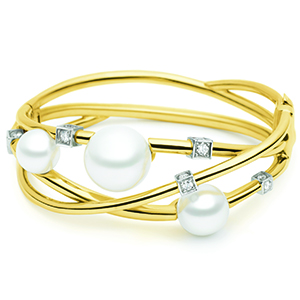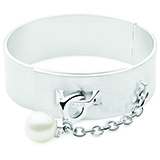
Pearls have the longest demonstrable history of any jewel, but the popularity of the lustrous gem has ebbed and flowed like the tide. Earlier last century, after becoming available in cheap and profuse cultivated or even plastic form, they became viewed as antiquated, deemed “fuddy-duddy” and only suitable for those over 60. However, over the past ten years, pearls have experienced an unexpected renaissance with the large South Sea cultured pearls found off Australia’s coast and historic examples of natural pearls like La Peregrina which was once owned by Queen Mary I and Elizabeth Taylor breathing new life into the industry.
A triumvirate of science, nature and industry have all played their part in restoring pearls to the fore.This article draws from findings in the journal article, “The long fall and curious rise of the pearl industry” by Sarah Shannon published in The Financial Times Limited in January 2017.
A Polished Alabaster History
In Shannon’s article, jewellery historian Beatriz Chadour-Sampson said mother-of-pearl was used as far back as 100,000 years. During the Roman Empire, Roman women were very keen on natural pearls, which were viewed as symbols of purity, beauty and fertility. Men often risked their lives to hand-collect them which made them even more desirable. Shannon’s article found Queen Elizabeth I lavishly adorned herself with pearls, as a symbol of her chastity and her kingdom’s affluence.
Just before Nicholas started diving for pearls in Australia, pearls arguably reached their high point in New York in 1917, when a deal was struck between Morton Freeman Plant and Pierre Cartier. Plant gave Cartier his Fifth Avenue mansion in exchange for $100 and a necklace of 128 natural pearls which were valued at $1m at the time. That mansion is now Cartier’s flagship store.

20th Century Revolution Leads to Mid-Century Collapse
Japanese entrepreneur Mikimoto Kokichi commercialised cultured pearls at the turn of the 20th century which revolutionised the industry. The scientific process of culturing pearls replaced the previous process of hand picking scarce natural pearls around the Gulf, India and Sri Lanka, and this changed the economics of the pearling industry.
But by the 1950s, Australia’s pearl industry collapsed due to over-harvesting and using plastics instead of mother-of-pearl. Paspaley learnt from the Japanese example, working with Japanese partners to master culturing methods for the Pinctada maxima oyster to produce South Sea pearls.
Kailis’ Place in Australia’s Pearling History
Kailis is synonymous with some of the most sought-after Australian South Sea pearls. Kailis general manager Tanya Tiddell said the Kailis family has a maritime history in Castellorizo, a small island in Greece, dating back more than 150 years.
“The Australian chapter of the family began in 1978 when the husband and wife team of Michael and Dr. Patricia Kailis pioneered pearl farming in the pristine waters off the remote north coast of Western Australia,” she said.
“Not long after, they opened the first pearl jewellery store in Broome. Over the past four decades Kailis pearl jewellery has become celebrated for its original designs which showcase the precious, untreated and natural beauty of these Australian oceanic gems.”
Tanya said that a Kailis Australian South Sea pearl is one of mother nature’s miracles, being both precious and rare and world-renowned for its natural beauty, value and scarcity. She said their natural beauty makes them so relevant in today’s world, as a symbol of modern sustainable luxury.

Riding the Waves of Fashion
In Shannon’s article, she states that prominent and influential women have aided the revival of pearls. She points to former US First Lady Michelle Obama who changed a lot about the way people view pearls, being seen wearing them in big chokers in a cool, modern way. Tanya from Kailis echoed a similar view, stating that pearls have seen a surge in popularity in recent years as a result of being seen on the runways of major fashion houses.
“I’d be surprised if there was ever a red carpet without a beautiful pearl necklace or pearl earrings!” she said.
Tanya said that in Australia, many of our most influential women from politicians to CEOs and more recently brand influencers seen on social media have been noted for wearing pearls. Tanya said prominent women sporting pearls gives exposure to millennial customers, but concedes that like everything, pearls are caught up in the fashion cycle.
“Kailis creates understated, elegant and timeless collections that span the ups and downs in popularity,” she said.
“Pearls are timeless…they have always been aspirational and a symbol of luxury.”

Trendy Ways to Wear the White Gem
While gently graduating strings were trendy in earlier fashions, in the 1990s, big South Sea cultured pearls became desirable. Tanya said trends of wearing pearls are always evolving.
“There is always a timeless pearl pendant, strands and earrings,” she said.
“Recently more modern looks include pearl cuffs and we have these in both silver and gold in various designs. Another modern look that has been adapted for pearls is earring jacks, with a pearl stud worn at the front and a jewellery piece added at the back to provide a different look, this allows the wearer to go with a classic look of studs or make it edgier with the jack attached at the back.”
Opening Tomorrow’s Oyster…
Tanya believes the pearl jewellery market will continue to go from strength to strength.
“As a natural product, each pearl is as unique as the wearer and as the market moves toward customers looking for an individual look, the pearl jewellery market will continue to grow,” she said.
“Once the wearer experiences the uniqueness of having pearls and the versatility of wearing them during the day and how they can easily transfer to nighttime, she will want to grow her collection of pieces to ensure she has something for every occasion.”